B1 - Cell Structure and Transport
1/55
There's no tags or description
Looks like no tags are added yet.
Name | Mastery | Learn | Test | Matching | Spaced |
|---|
No study sessions yet.
56 Terms
Define the term resolution
Resolution is the smallest distance between two objects that can be distinguished
Define the term magnification
Magnification is the number of times bigger an image appears to be compared to the size of the real object
How can magnification be calculated?
Magnification = size of image/size of real object

How does a light microscope work?
Light microscopes pass a beam of light through a specimen which travels through the eyepiece lens, allowing the specimen to be observed.
How does an electron microscope work?
An electron microscope uses a beam of electrons which are focused using magnets. The electrons hit a fluorescent screen which emits visible light, producing an image.
List the resolution and magnification of light and electron microscopes
Light microscopes
- Magnify up to about x2000
- Resolving power of about 200nm
Electron microscopes
- Magnify up to about x2000000
- Resolving power of about 0.2nm
What are the advantages of using light microscopes? (4)
- Inexpensive
- Easy to use
- Portable
- Can observe both dead and living specimens
What are the disadvantages of using a light microscope?
It has a limited resolution
What are the advantages of using an electron microscope?
It has a greater magnification and resolution
What are the disadvantages of using an electron microscope? (4)
- Expensive
- Large (so less portable)
- Require training to use
- Only dead specimens can be observed
Name the two types of electron microscopes
1) SEM - Scanning electron microscope
2) TEM - Transmission electron microscope
What is the main difference between SEM and TEM?
- SEM creates an image by detecting reflected or knocked off electrons
- TEM creates an image using transmitted electrons (electrons that are passing through the sample)
Why do electron microscopes have a greater magnification and resolution?
They use a beam of electrons which has a shorter wavelength than protons of light
How have electron microscopes enabled scientist to develop their understanding of cells
Electron microscopes allow small, sub-cellular structures to be observed in detail. This helps scientists develop more accurate explanations about how cell structures relate to their functions
List the components of both plant and animal cells (5)
- Nucleus
- Cytoplasm
- Cell membrane
- Mitochondria
- Ribosomes
List the additional cell components found in plant cells (3)
- Chloroplasts
- Permanent vacuole
- Cell wall
Other than storing genetic information, what is the function of the nucleus?
Controls cellular activities
What is the function of chloroplasts?
Chloroplasts are found in all the green parts of a plant. They are green as they contain a green pigment called chlorophyll. Chlorophyll absorbs light so the plant can carry out photosynthesis.
What does the permanent vacuole contain?
Cell sap (a solution of salts, sugars and organic acids)
What is the function of the cell membrane?
Controls the entry and exit of materials in the cell
What is the function of the ribosomes?
Protein synthesis takes place in the ribosomes, making all the proteins needed in the cell
What is the function of the cytoplasm?
- Transport median for chemical reactions
- Provides a platform where other organelles can operate within the cell
What is the plant cell wall made up of?
Cellulose, which strengthens the cell and gives it support
What is the function of the plant cell wall?
It provides strength and prevents the cell from bursting when water enters the cell through osmosis
Describe the structure of the cytoplasm
The cytoplasm is the liquid gel component of the cell, and it contains organelles, enzymes and dissolved ions and nutrients. Most of the chemical reactions needed for life take place here.
What is the function of the permanent vacuole?
- It is filled with cell sap which keeps the cell rigid
What is the function of the mitochondria?
- Contains structures in the cytoplasm where aerobic respiration takes place, releasing energy for the cell
What are the two types of cells?
Eukaryotic (plant and animal cells) and prokaryotic (bacterial cells)
What is the prokaryotic cell wall composed of?
Peptidoglycan
What are the differences between prokaryotic and eukaryotic cells?
- Prokaryotic cells are much smaller than eukaryotic cells
- Eukaryotic cells have membrane bound organelles and a nucleus containing genetic material (prokaryotes don’t have these features)
How is genetic material stored in a prokaryotic cell?
Genetic material is found free within the cytoplasm as:
- Chromosomal DNA (single large loop of circular DNA)
- Plasmid DNA
What are plasmids?
- Small, circular loops of DNA found free in the cytoplasm and separate from the main DNA
- Carry genes that provide genetic advantages, eg: antibiotic resistance
Describe how sperm cells are adapted to their function
Sperm cells have:
- A haploid nucleus containing genetic information
- Tail (that enables movement)
- Mitochondria (provides energy for movement)
- Acrosome contains enzymes that digest the egg cell membrane
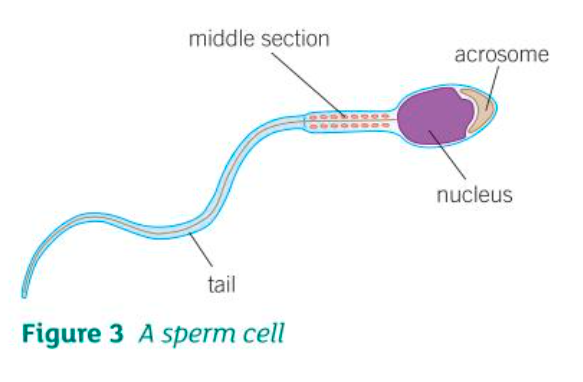
Describe how muscle cells are adapted to their function
Muscle cells have:
- An arrangement of protein filaments which allow them to slide over each other to produce muscle contraction
- Mitochondria (that provides energy for muscle contraction)
- Merged cells in skeletal muscles to allow muscle fibre contractions in unison
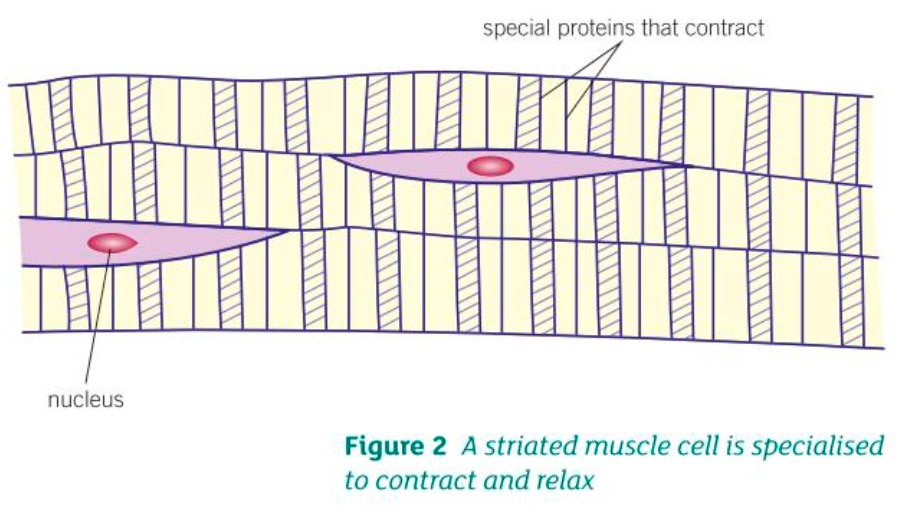
Describe how nerve cells are adapted to their function
Nerve cells have:
- A long axon body that allows electrical impulses to be transmitted all over the body from the nervous system
- Dendrites that connect to the cell body and receive impulses from other nerve cells, muscles and glands
- Myelin sheath that insulates the axon and speeds up transmissions of impulses

List three adaptations of striated muscles
- The contain special proteins that slide over each other, making the fibres contract
- They contain mitochondria to transfer the energy needed for the chemical reactions that take place as the cells contract and relax
- They also store glycogen
Describe how root hair cells are adapted to their function
Root hair cells have:
- A large surface area to absorb nutrients and water from the surrounding soil
- Thin walls that allow water to pass through easily
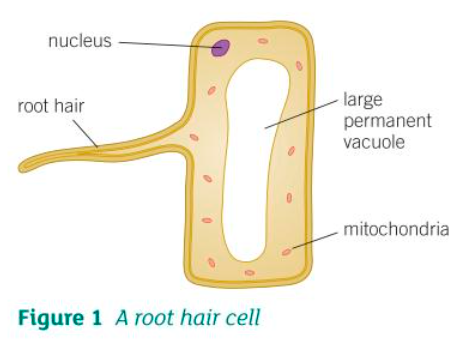
Describe how xylem cells are adapted to their function
Xylem cells have:
- No upper or lower margins between cells which provides a continuous route for water to flow
- Thick, lignin spirals/rings help strengthen their structure and prevent the cell from collapsing

Describe how phloem cells are adapted to their function
Phloem cells have:
- Sieve plates that let dissolved amino acids and sugars be transported up and down the cell
- Companion cells provide energy needed for active transport of substances along the phloem
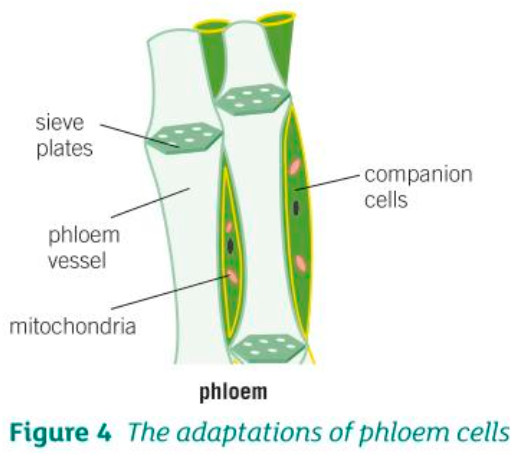
What is diffusion?
The net movement of particles from an area of high concentration to an area of low concentration
What three main factors affect the rate of diffusion?
1) Concentration gradient: Larger gradient, faster diffusion
2) Temperature: Higher temperature, faster diffusion
3) Surface area: Large SA, faster diffusion
Give examples of substances transported by diffusion in the lungs and the kidney
- Lungs: Oxygen diffuses into the blood from the lungs and carbon dioxide diffuses into the lungs from the blood, both down a concentration gradient
- Kidney: Urea diffuses from cells into blood plasma so it can be excreted in urine
How are single-celled organisms adapted for diffusion?
They have a large SA:V ratio which maximizes the rate of diffusion of molecules to meet the organism’s needs
What four factors increase the effectiveness of a gas exchange surface?
1) Large surface area
2) Thin membrane (short diffusion pathways)
3) Efficient blood supply (animals)
4) Ventilation (animals)
What is osmosis?
Movement of water from a dilute solution to a concentrated solution through a partially permeable membrane
What is meant when a solution is isotonic to a cell?
The concentrations of the external and internal (inside cell) solutions are the same
ISO - Normal (equal amount of molecules)
What is meant when a solution is hypertonic to a cell?
The concentration of the solution is higher than that of the internal solution (inside cell)
HYPER - Concentrated (more molecules)
What is meant when a solution is hypotonic to a cell?
The concentration of the external solution is lower than that of the internal solution (inside cell)
HYPO - Dilute (less molecules)
What may happen if an animal cell is placed inside a isotonic/hypertonic/hypotonic solution?
ISOTONIC - Normal
HYPERTONIC - Water moves out of the cell, causing it to shrivel up
HYPOTONIC - Water moves into the cell causing it to burst

What may happen if a plant cell is placed inside a isotonic/hypertonic/hypotonic solution?
ISOTONIC - Normal
HYPERTONIC - Water moves out of the cell, causing it to become flaccid. the vacuole and cytoplasm decrease in size. The cell membrane also pulls away from the cell wall, causing the cell to become plasmolyzed
HYPOTONIC - Water moves into the cell, causing the vacuole to swell and press the cytoplasm against the cell wall. This increases turgor pressure, making the cell turgid (firm and rigid).
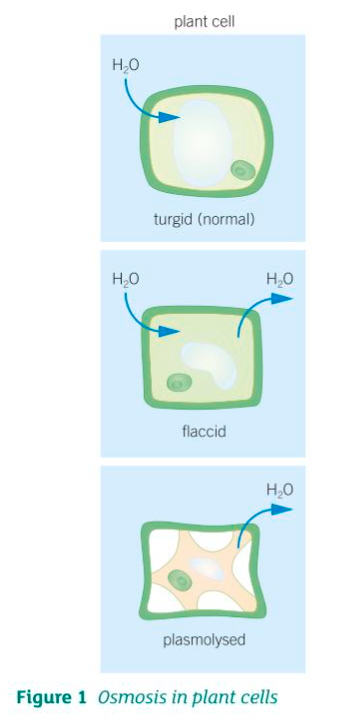
Required Practical: Investigating Osmosis in Plant Cells
Materials:
- Plant tissues (potato, sweet potato, beetroot)
- Salt or sugar solutions
- Cutting tools
- Balance for mass measurement
Procedure:
1) Prepare Plant Tissues
- Cut tissues into cylinders, chips, or discs.
- Potatoes are common due to their uniform structure.
2) Experiment
- Immerse tissues in various concentrations of salt/sugar solutions.
- Measure initial mass and surface area.
- After a set time, blot dry and measure final mass.
- Calculate mass changes to assess water uptake or loss.
Considerations:
- Choosing Solutes: Use salt/sugar for their solubility. Conduct preliminary trials to see which gives clearer results.
- Plant Tissue Selection: Potatoes are easy to use; compare with sweet potato and beetroot for different responses.
- Tissue Forms: Cylinders, chips, and discs vary in surface area and handling ease. Test which gives the most consistent results.
- Surface Area Impact: Larger surface area increases osmosis rate. Plan and test samples with different surface areas.
Safety: Use cutting tools carefully to prevent injuries.
How do plant leaves and stems remain rigid?
Due to turgor pressure - water moves in by osmosis, causing the vacuole to swell and the cytoplasm to press against the cell wall
What is active transport?
The movement of molecules from a dilute solution to a concentrated solution against a concentration gradient, using energy from respiration
How do plant root hair cells use active transport?
To take up mineral ions from a more dilute solution in soils. Ions such as magnesium and nitrates are required for healthy growth
How is active transport used to absorb the products of digestion?
Active transport is used to transport glucose from a lower concentration in the gut to a higher concentration in the blood. Glucose is then transported to the tissues where it can be used in respiration.
How does a cell become specialised?
Cells become specialised through a process called cell differentiation